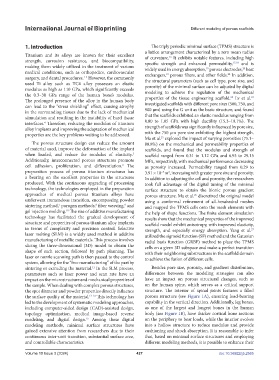Page 435 - IJB-10-3
P. 435
International Journal of Bioprinting Different modeling of porous scaffolds
1. Introduction The triply periodic minimal surface (TPMS) structure is
a lattice arrangement characterized by a zero mean radius
Titanium and its alloys are known for their excellent of curvature. It exhibits notable features, including high
16
strength, corrosion resistance, and biocompatibility, specific strength and enhanced permeability, 17,18 and is
making them widely utilized in the treatment of various widely used in energy absorption, porous electrodes, heat
19
20
medical conditions, such as orthopedics, cardiovascular exchangers, porous filters, and other fields. In addition,
22
21
surgery, and dental procedures. However, the commonly the structural parameters (such as cell type, pore size, and
1-3
used Ti alloy such as TC4 alloy possesses an elastic porosity) of the minimal surface can be adjusted by digital
modulus as high as 110 GPa, which significantly exceeds modeling to achieve the regulation of the mechanical
the 0.3–30 GPa range of the human bone’s modulus. 23 24
The prolonged presence of the alloy in the human body properties of the tissue engineering scaffold. Lv et al.
can lead to the “stress shielding” effect, causing atrophy investigated scaffolds with different pore sizes (500, 750, and
in the surrounding tissues due to the lack of mechanical 900 μm) using the G unit as the basic structure, and found
stimulation and resulting in the instability of hard tissue that the scaffolds exhibited an elastic modulus ranging from
4
interfaces. Therefore, reducing the modulus of titanium 0.80 to 1.05 GPa with high ductility (15.3–19.1%). The
alloy implants and improving the adaptation of mechanical strength of scaffolds was significantly influenced by pore size,
properties are the key problems waiting to be addressed. with the 750 μm pore size exhibiting the highest strength.
Ma et al. explored the impact of varying porosities (75.1–
25
The porous structure design can reduce the amount 88.8%) on the mechanical and permeability properties of
of material used, improve the deformation of the implant scaffolds, and found that the modulus and strength of
5
when loaded, and reduce the modulus of elasticity. scaffold ranged from 0.31 to 1.12 GPa and 6.93 to 29.15
Additionally, interconnected porous structures promote MPa, respectively, with mechanical performance decreasing
cell adhesion, proliferation, and differentiation. The as porosity increased. Permeability ranged from 0.29 to
6
preparation process of porous titanium structures has 3.91 × 10 m , increasing with greater pore size and porosity.
−9
2
a bearing on the excellent properties in the structures In addition to adjusting the cell and porosity, the researchers
produced. With the continuous upgrading of processing took full advantage of the digital tuning of the minimal
technology, the technologies employed in the preparation surface structure to obtain the bionic porous gradient
approaches of medical porous titanium alloys have porous structure. Ma et al. discretized the original model
26
underwent tremendous transition, encompassing powder using a conformal refinement of all-hexahedral meshes
sintering method, porogen methods, fiber weaving, and and mapped the TPMS cells onto the mesh elements with
8
7
9
10
gel injection molding. The rise of additive manufacturing the help of shape functions. The finite element simulation
technology has facilitated the gradual development of results show that the mechanical properties of the improved
structure and properties of porous titanium alloy implants scaffold model exhibit anisotropy, with improved elasticity,
in terms of complexity and precision control. Selective strength, and especially energy absorption. Yang et al.
27
laser melting (SLM) is a widely used method in additive utilized the sigmoid function (SF) method and the Gaussian
manufacturing of metallic materials. This process involves radial basis function (GRBF) method to place the TPMS
slicing the three-dimensional (3D) model to obtain the cells on a given 3D subspace and make a perfect transition
shape of each section, followed by path planning. The with their neighboring substructures in the scaffold domain
laser or nozzle scanning path is then passed to the control to achieve the fusion of different cells.
system, allowing for the “free manufacturing” of the part by
sintering or extruding the material. In the SLM process, Besides pore size, porosity, and gradient distribution,
11
parameters such as laser power and scan rate have an differences between the modeling strategies can also
impact on the microstructure and mechanical properties of have an impact on porous structural changes, such as
the sample. When dealing with complex porous structures, on the human spine, which serves as a critical support
the spot diameter and powder properties directly influence structure. The interior of spinal joints features a filled
the surface quality of the material. 12-14 This technology has porous structure (see Figure 1A), ensuring load-bearing
led to the development of systematic modeling approaches, capability in the vertical direction. Additionally, leg bones,
including computer-aided design (CAD)-assisted design, as one of the largest and longest bones in the human
topology optimization, medical image-based reverse body (see Figure 1B), have thicker cortical bone sections
modeling, and digital design. Among these digital on the periphery to bear loads, while the interior evolves
15
modeling methods, minimal surface structures have into a hollow structure to reduce modulus and provide
gained extensive attention from researchers due to their cushioning and shock absorption. It is reasonable to infer
continuous inter-unit transition, substantial surface area, that, based on minimal surface structures and employing
and controllable characteristics. different modeling methods, it is possible to enhance their
Volume 10 Issue 3 (2024) 427 doi: 10.36922/ijb.2565

